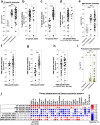COVID-19 Severity Is Associated with Differential Antibody Fc-Mediated Innate Immune Functions
- PMID: 33879594
- PMCID: PMC8092230
- DOI: 10.1128/mBio.00281-21
COVID-19 Severity Is Associated with Differential Antibody Fc-Mediated Innate Immune Functions
Erratum in
-
Erratum for Adeniji et al., "COVID-19 Severity Is Associated with Differential Antibody Fc-Mediated Innate Immune Functions".mBio. 2021 Jun 29;12(3):e0124421. doi: 10.1128/mBio.01244-21. Epub 2021 Jun 8. mBio. 2021. PMID: 34098736 Free PMC article. No abstract available.
Abstract
Beyond neutralization, antibodies binding to their Fc receptors elicit several innate immune functions including antibody-dependent complement deposition (ADCD), antibody-dependent cell-mediated phagocytosis (ADCP), and antibody-dependent cell-mediated cytotoxicity (ADCC). These functions are beneficial, as they contribute to pathogen clearance; however, they also can induce inflammation. We tested the possibility that qualitative differences in SARS-CoV-2-specific antibody-mediated innate immune functions contribute to coronavirus disease 2019 (COVID-19) severity. We found that anti-S1 and anti-RBD antibodies from hospitalized COVID-19 patients elicited higher ADCD but lower ADCP compared to antibodies from nonhospitalized COVID-19 patients. Consistently, higher ADCD was associated with higher systemic inflammation, whereas higher ADCP was associated with lower systemic inflammation during COVID-19. Our study points to qualitative, differential features of anti-SARS-CoV-2 specific antibodies as potential contributors to COVID-19 severity. Understanding these qualitative features of natural and vaccine-induced antibodies will be important in achieving optimal efficacy and safety of SARS-CoV-2 vaccines and/or COVID-19 therapeutics.IMPORTANCE A state of hyperinflammation and increased complement activation has been associated with coronavirus disease 2019 (COVID-19) severity. However, the pathophysiological mechanisms that contribute to this phenomenon remain mostly unknown. Our data point to a qualitative, rather than quantitative, difference in SARS-CoV-2-specific antibodies' ability to elicit Fc-mediated innate immune functions as a potential contributor to COVID-19 severity and associated inflammation. These data highlight the need for further studies to understand these qualitative features and their potential contribution to COVID-19 severity. This understanding could be essential to develop antibody-based COVID-19 therapeutics and SARS-CoV-2 vaccines with an optimal balance between efficacy and safety.
Keywords: COVID-19; Fc-mediated functions; SARS-CoV-2; antibody; inflammation.
Copyright © 2021 Adeniji et al.
Figures


References
-
- Guan WJ, Ni ZY, Hu Y, Liang WH, Ou CQ, He JX, Liu L, Shan H, Lei CL, Hui DSC, Du B, Li LJ, Zeng G, Yuen KY, Chen RC, Tang CL, Wang T, Chen PY, Xiang J, Li SY, Wang JL, Liang ZJ, Peng YX, Wei L, Liu Y, Hu YH, Peng P, Wang JM, Liu JY, Chen Z, Li G, Zheng ZJ, Qiu SQ, Luo J, Ye CJ, Zhu SY, Zhong NS, China Medical Treatment Expert Group for Covid-19. 2020. Clinical characteristics of coronavirus disease 2019 in China. N Engl J Med 382:1708–1720. doi:10.1056/NEJMoa2002032. - DOI - PMC - PubMed
-
- Blanco-Melo D, Nilsson-Payant BE, Liu WC, Uhl S, Hoagland D, Moller R, Jordan TX, Oishi K, Panis M, Sachs D, Wang TT, Schwartz RE, Lim JK, Albrecht RA, tenOever BR. 2020. Imbalanced host response to SARS-CoV-2 drives development of COVID-19. Cell 181:1036–1045.e9. doi:10.1016/j.cell.2020.04.026. - DOI - PMC - PubMed
-
- Chen G, Wu D, Guo W, Cao Y, Huang D, Wang H, Wang T, Zhang X, Chen H, Yu H, Zhang X, Zhang M, Wu S, Song J, Chen T, Han M, Li S, Luo X, Zhao J, Ning Q. 2020. Clinical and immunological features of severe and moderate coronavirus disease 2019. J Clin Invest 130:2620–2629. doi:10.1172/JCI137244. - DOI - PMC - PubMed
Publication types
MeSH terms
Substances
Grants and funding
LinkOut - more resources
Full Text Sources
Other Literature Sources
Medical
Miscellaneous

